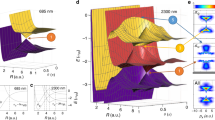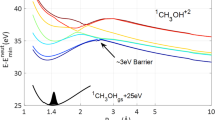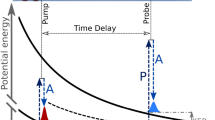Abstract
In the extreme ultraviolet and soft-X-ray regions of the spectrum, light–matter interaction is dominated by photoionization. In molecular systems, the sudden removal of an electron will initiate ultrafast electronic and nuclear dynamics in the residual molecular ion. A particularly interesting aspect of these dynamics is the correlated motions of electrons and nuclei, an understanding of which lies at the heart of chemistry. Here we use a few-femtosecond high-harmonic pulse and a weak infrared laser pulse to initiate and probe the explosion of a triatomic N2O+ molecular ion in real time, in a regime dominated by coupled electron–electron and electron–nuclear dynamics. We also show that the branching ratio of bond breaking can be altered in the presence of the laser field.
This is a preview of subscription content, access via your institution
Access options
Subscribe to this journal
Receive 12 print issues and online access
$209.00 per year
only $17.42 per issue
Buy this article
- Purchase on Springer Link
- Instant access to full article PDF
Prices may be subject to local taxes which are calculated during checkout




Similar content being viewed by others
References
Popmintchev, T., Chen, M. C., Arpin, P., Murnane, M. M. & Kapteyn, H. C. The attosecond nonlinear optics of bright coherent X-ray generation. Nature Photon. 4, 822–832 (2010).
Ullrich, J. et al. Recoil-ion momentum spectroscopy. J. Phys. B. 30, 2917–2974 (1997).
Becker, U. & Shirley, D. A. VUV and Soft X-Ray Photoionization (Springer, 1996).
Uiberacker, M. et al. Attosecond real-time observation of electron tunnelling in atoms. Nature 446, 627–632 (2007).
Drescher, M., Hentschel, M., Kienberger, R. & Uiberacker, M. Time-resolved atomic inner-shell spectroscopy. Nature 419, 803–807 (2002).
Sandhu, A. S. et al. Observing the creation of electronic Feshbach resonances in soft X-ray-induced O2 dissociation. Science 322, 1081–1085 (2008).
Gagnon, E. et al. Soft X-ray-driven femtosecond molecular dynamics. Science 317, 1374–1378 (2007).
Cao, W. et al. Dynamic modification of the fragmentation of COq+ excited states generated with high-order harmonics. Phys. Rev. A 82, 043410 (2010).
Hatano, Y. Spectroscopy and dynamics of molecular superexcited states. Aspects of primary processes of radiation chemistry. Radiat. Phys. Chem. 67, 187–198 (2003).
Hjelte, I. et al. Evidence for ultra-fast dissociation of molecular water from resonant Auger spectroscopy. Chem. Phys. Lett. 334, 151–158 (2001).
Eland, J. H. D. Dynamics of double photoionization in molecules and atoms. Adv. Chem. Phys. 141, 103–151 (2009).
Scheit, S., Cederbaum, L. S. & Meyer, H. D. Time-dependent interplay between electron emission and fragmentation in the interatomic Coulombic decay. J. Chem. Phys. 118, 2092–2107 (2003).
Sisourat, N. et al. Ultralong-range energy transfer by interatomic Coulombic decay in an extreme quantum system. Nature Phys. 6, 508–511 (2010).
Strasser, D., Haber, L. H., Doughty, B. & Leone, S. R. Ultrafast predissociation of superexcited nitrogen molecules. Mol. Phys. 106, 275–280 (2008).
Eland, J. H. D. Double photoionisation spectra of methane, ammonia and water. Chem. Phys. 323, 391–396 (2006).
Levis, R. J., Menkir, G. M. & Rabitz, H. Selective bond dissociation and rearrangement with optimally tailored, strong-field laser pulses. Science 292, 709–713 (2001).
Daniel, C. et al. Deciphering the reaction dynamics underlying optimal control laser fields. Science 299, 536–539 (2003).
Field, T. A. & Eland, J. H. D. Lifetimes of metastable molecular doubly-charged ions. Chem. Phys. Lett. 211, 436–442 (1993).
Hsieh, S. & Eland, J. H. D. Reaction dynamics of three-body dissociations in triatomic molecules from single-photon double ionization studied by a time- and position-sensitive coincidence method. J. Phys. B. 30, 4515–4534 (1997).
Price, S. D., Eland, J. H. D., Fournier, P. G., Fournier, J. & Millie, P. Electronic states and decay mechanisms of the N2O2+ dication. J. Chem. Phys. 88, 1511–1515 (1988).
Levasseur, N. & Millie, P. Potential-energy surfaces of the low-lying states of N2O++ and photodissociation mechanisms. J. Chem. Phys. 92, 2974–2983 (1990).
Holland, D. M. P., Macdonald, M. A. & Hayes, M. A. A photoelectron study of the inner valence molecular-orbitals of N2O. Chem. Phys. 142, 291–300 (1990).
Domcke, W. et al. Experimental and theoretical investigation of the complete valence shell ionization spectra of CO2 and N2O. Chem. Phys. 40, 171–183 (1979).
Ehara, M., Yasuda, S. & Nakatsuji, H. Fine theoretical spectroscopy using SAC-CI general-R method: Outer- and inner-valence ionization spectra of N2O and HN3 . Z. Phys. Chem. 217, 161–176 (2003).
Erman, P. et al. Ultrashort-lived non-Rydberg doubly excited resonances observed in molecular photoionization. Phys. Rev. Lett. 76, 4136–4139 (1996).
Wang, H. et al. Attosecond time-resolved autoionization of argon. Phys. Rev. Lett. 105, 143002 (2010).
Li, W. et al. Visualizing electron rearrangement in space and time during the transition from a molecule to atoms. Proc. Natl Acad. Sci. USA 107, 20219–20222 (2010).
Miron, C., Simon, M., Leclercq, N., Hansen, D. L. & Morin, P. Site-selective photochemistry of core excited molecules: Role of the internal energy. Phys. Rev. Lett. 81, 4104–4107 (1998).
Kinmond, E., Eland, J. H. D. & Karlsson, L. Dissociation of N2O+ ions from the valence states reached by one-photon photoionisation. Int. J. Mass. Spec. 187, 437–447 (1999).
Masuoka, T. Observation of anisotropic angular-distribution of ionic fragments in the dissociation of CO2+. Phys. Rev. A 50, 2298–2303 (1994).
Acknowledgements
The authors gratefully acknowledge financial support from Department of Energy (DOE) Basic Energy Sciences (BES) Chemical Sciences and used facilities provided by the National Science Foundation Engineering Research Center for Extreme Ultraviolet Science (NSF EUV ERC). We thank O. Vendrell and R. Santra for critical comments of the manuscript, and X-M. Tong illuminating discussions. We also thank A. Czasch and T. Jahnke from RoentDek for the COLTRIMS support, and Y. Liu for providing us the EUV multilayer mirrors.
Author information
Authors and Affiliations
Contributions
X.Z., M.M.M. and H.C.K. conceived the project. X.Z., P.R. and C.W.H. performed the experiments and analysed the data. All authors contributed to the data interpretation and paper.
Corresponding authors
Ethics declarations
Competing interests
The authors declare no competing financial interests.
Supplementary information
Supplementary Information
Supplementary Information (PDF 476 kb)
Rights and permissions
About this article
Cite this article
Zhou, X., Ranitovic, P., Hogle, C. et al. Probing and controlling non-Born–Oppenheimer dynamics in highly excited molecular ions. Nature Phys 8, 232–237 (2012). https://doi.org/10.1038/nphys2211
Received:
Accepted:
Published:
Issue Date:
DOI: https://doi.org/10.1038/nphys2211
This article is cited by
-
Time-resolving the ultrafast H2 roaming chemistry and H3+ formation using extreme-ultraviolet pulses
Communications Chemistry (2020)
-
Electron correlation driven non-adiabatic relaxation in molecules excited by an ultrashort extreme ultraviolet pulse
Nature Communications (2019)
-
XUV excitation followed by ultrafast non-adiabatic relaxation in PAH molecules as a femto-astrochemistry experiment
Nature Communications (2015)
-
Exploring new avenues in high repetition rate table-top coherent extreme ultraviolet sources
Light: Science & Applications (2015)
-
Diatomic dications and dianions
Journal of the Iranian Chemical Society (2014)



